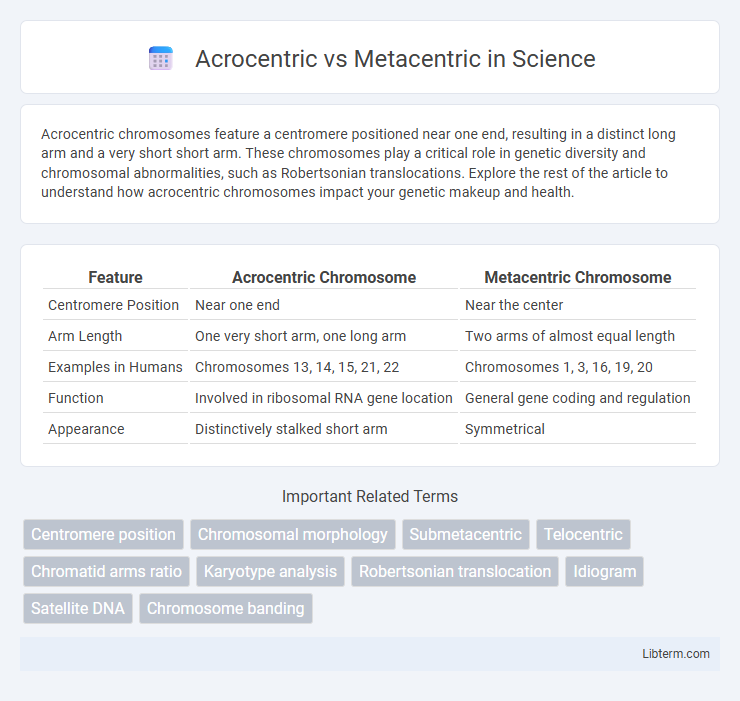Acrocentric chromosomes feature a centromere positioned near one end, resulting in a distinct long arm and a very short short arm. These chromosomes play a critical role in genetic diversity and chromosomal abnormalities, such as Robertsonian translocations. Explore the rest of the article to understand how acrocentric chromosomes impact your genetic makeup and health.
Table of Comparison
| Feature | Acrocentric Chromosome | Metacentric Chromosome |
|---|---|---|
| Centromere Position | Near one end | Near the center |
| Arm Length | One very short arm, one long arm | Two arms of almost equal length |
| Examples in Humans | Chromosomes 13, 14, 15, 21, 22 | Chromosomes 1, 3, 16, 19, 20 |
| Function | Involved in ribosomal RNA gene location | General gene coding and regulation |
| Appearance | Distinctively stalked short arm | Symmetrical |
Introduction to Chromosome Morphology
Chromosome morphology is characterized by the positioning of the centromere, which distinguishes acrocentric chromosomes from metacentric chromosomes. Acrocentric chromosomes have the centromere near one end, resulting in one very short (p) arm and one long (q) arm, commonly found in human chromosomes 13, 14, 15, 21, and 22. Metacentric chromosomes possess a centrally located centromere, producing arms of roughly equal length, typical of human chromosomes 1, 3, 16, and 19, providing key insights into karyotype structure and genetic analysis.
Defining Acrocentric Chromosomes
Acrocentric chromosomes are defined by having the centromere positioned closer to one end, producing a long arm and a significantly shorter arm. This structural characteristic differs from metacentric chromosomes, where the centromere lies near the middle, resulting in arms of roughly equal length. Human chromosomes 13, 14, 15, 21, and 22 are classic examples of acrocentric chromosomes, each featuring satellited short arms important in nucleolar organization.
Features of Metacentric Chromosomes
Metacentric chromosomes are characterized by a centrally located centromere, resulting in two arms of approximately equal length. This balanced structure facilitates equal segregation during cell division, reducing the likelihood of chromosomal abnormalities. The symmetrical design also allows for efficient organization and packaging of genetic material within the nucleus.
Key Differences Between Acrocentric and Metacentric Chromosomes
Acrocentric chromosomes feature a centromere positioned near one end, resulting in a very short p arm and a longer q arm, whereas metacentric chromosomes have a centrally located centromere, producing arms of approximately equal length. Acrocentric chromosomes often carry nucleolus organizer regions (NORs) involved in ribosomal RNA synthesis, a characteristic absent from metacentric chromosomes. The structural differences influence chromosome behavior during cell division, with metacentric chromosomes typically exhibiting more balanced segregation compared to the asymmetric nature of acrocentric chromosomes.
Centromere Position and Chromosome Function
Acrocentric chromosomes have the centromere located near one end, creating a long arm and a very short arm, which influences their role in forming nucleolar organizer regions important for ribosomal RNA synthesis. Metacentric chromosomes possess a centrally positioned centromere, resulting in two arms of approximately equal length, facilitating balanced genetic segregation during cell division. The centromere position in these chromosomes directly affects their structural stability and function in genetic inheritance.
Chromosomal Examples in Humans and Model Organisms
Acrocentric chromosomes in humans, such as chromosomes 13, 14, 15, 21, and 22, have centromeres near one end, resulting in a long arm and a very short arm, prominently featuring ribosomal RNA gene clusters. Metacentric chromosomes, like human chromosome 1 and chromosome 3, have centrally located centromeres creating arms of roughly equal length, a structure also observed in model organisms such as Drosophila melanogaster. In mice (Mus musculus), most chromosomes are metacentric or submetacentric, contrasting with the predominantly acrocentric chromosomes in humans, which is significant for studies on chromosomal behavior and genetic mapping.
Role of Acrocentric and Metacentric Chromosomes in Genetics
Acrocentric chromosomes, characterized by a centromere near one end, play a crucial role in forming nucleolus organizer regions (NORs) responsible for ribosomal RNA synthesis, impacting protein production and cell function. Metacentric chromosomes, with a centrally positioned centromere, ensure balanced chromatid segregation during cell division, maintaining genomic stability and proper gene expression. Both chromosome types contribute to genetic diversity and chromosome behavior, influencing inheritance patterns and susceptibility to chromosomal abnormalities.
Implications for Genetic Disorders and Syndromes
Acrocentric chromosomes, characterized by a centromere near one end, are prone to Robertsonian translocations, which can lead to genetic disorders such as Down syndrome due to chromosomal rearrangements involving chromosomes 13, 14, 15, 21, and 22. Metacentric chromosomes, with centrally located centromeres, generally exhibit more stable segregation during meiosis but can be involved in balanced translocations that may result in syndromes depending on the genes impacted by the breakpoints. Understanding the structural differences between acrocentric and metacentric chromosomes aids in diagnosing chromosomal abnormalities that contribute to various genetic syndromes and informs reproductive risk assessments.
Importance in Karyotyping and Cytogenetic Studies
Acrocentric and metacentric chromosomes play a critical role in karyotyping and cytogenetic studies by providing distinct structural markers essential for chromosome identification and classification. The position of the centromere differentiates acrocentric chromosomes, characterized by a centromere near one end, from metacentric chromosomes with a centrally located centromere, influencing the shape and banding patterns used in genetic analysis. Accurate recognition of these chromosome types is vital for diagnosing chromosomal abnormalities, understanding genetic disorders, and conducting evolutionary studies in clinical and research cytogenetics.
Summary and Future Directions in Chromosome Research
Acrocentric chromosomes feature centromeres near one end, creating one long arm and one very short arm, while metacentric chromosomes have centromeres near the middle, resulting in arms of roughly equal length. Current research emphasizes the role of acrocentric short arms in nucleolar organization and genome stability, highlighting their significance in chromosomal rearrangements and diseases. Future directions include advanced genome sequencing and CRISPR-based technologies to unravel the functional complexities of centromere positioning and its impact on chromosomal behavior and inheritance patterns.
Acrocentric Infographic

 libterm.com
libterm.com